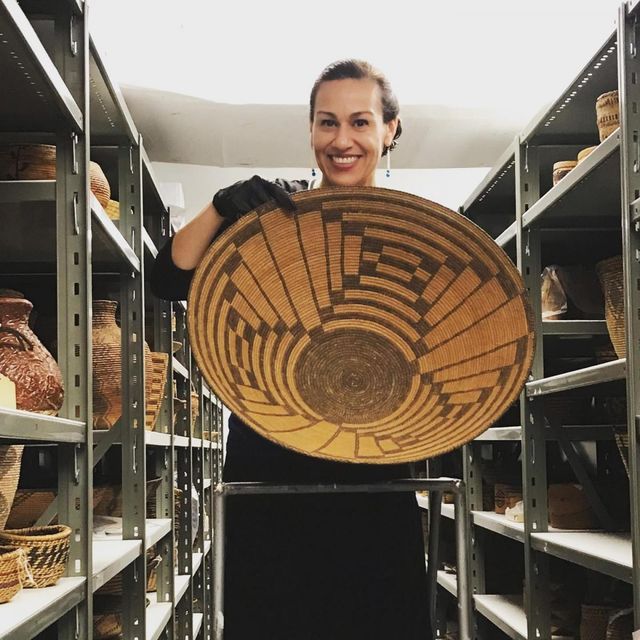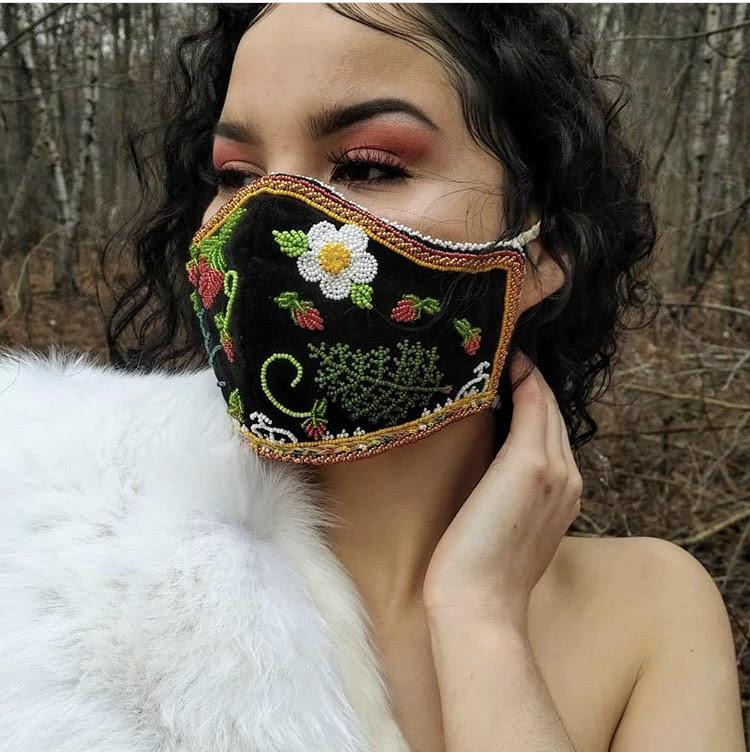
The Smithsonian American Art Museum recently acquired three face masks created by Indigenous women artists in response to the COVID-19 pandemic. These accomplished beadwork artists and basket makers utilized diverse materials and artistic techniques onto their protective face coverings.
In mid-March when SAAM’s Renwick Gallery and the other Smithsonian museums closed due to the pandemic, the Renwick curators envisaged how to document the current moment. The curators have been guided both by the gallery’s vision of celebrating makers taking both innovative and time-honored approaches to their work as well as the pronouncement by Secretary of the Smithsonian Lonnie Bunch that “the job of a museum is not just to look back. It’s to collect today for tomorrow.”
The three masks were exhibited in the virtual art exhibition, Masked Heroes: Facial Coverings by Native Artists, launched in April 2020 and organized by First American Art Magazine. More than seventy artists submitted 125 functional and artistic face mask creations using cloth, leather, cedar bark, plastic, and other materials. The magazine’s editor, America Meredith (Cherokee Nation of Oklahoma), wanted to “celebrate the resilience of Indigenous peoples and help share the beauty that Native artists have created in the face of our shared crisis.”
The three masks are currently on view in the second-floor permanent collection galleries at the Renwick. Below, each artist has shared more about her artistic practice and the messages of strength, resilience, and hope behind the masks.
Katrina Mitten
Katrina Mitten is a bead artist and a citizen of the Miami Tribe of Oklahoma. She lives in a small town on the traditional homelands of her people and is descended from Miami chiefs, including Meshingomesia (Little Turtle), Peshewa (Jean Baptiste Richardville), and Topah (Francis LaFontaine). At the age of twelve, Mitten began learning the traditional arts of the Miami people, focusing on beadwork and traditional clothing. She entered her first juried competition twenty years ago, and since then, Mitten has won many awards across for her beadwork, including first place in beadwork at the 2011 Eiteljorg Museum Art Market. She has been an artist-in-residence at the Eiteljorg Museum and the Ziibiwing Cultural Center.
Mitten’s MMIW (Missing and Murdered Indigenous Women) face mask is beaded with a red handprint in Czech seed beads and sewn with cotton fabric and ribbon. The top border of the mask is decorated with shell discs and the bottom fringe consists of bone hair pipes and teardrop beads. In the United States, Indigenous women experience violence greater than any other population of women. “The MMIW atrocity,” as Mitten explained, “has inspired me in a few of my pieces including this mask. Many women use the hand symbol across the mouth as a symbol of this movement to bring attention to the horrible injustices that are occurring in indigenous communities throughout North America. Having to wear protective masks for our health would cover those who choose to paint the handprint on their faces, so I decided to bead it to the mask.”
Vicki Soboleff
Vicki Soboleff is a Haida artist, dancer, and teacher born in Seattle, Washington, and raised in Ketchikan, Alaska. Her Haida grandmother Vesta Johnson passed along traditions, songs, dances, and the Haida language to her. Soboleff then learned Haida basketry from master weavers Selina Peratrovich, Delores Churchill, and Janice Criswell. Soboleff also apprenticed with Cheryl Samuel and Kay Parker on Ravenstail weaving. In 1995, she formed the youth dance group Lda Kut Naax Sati Yatx’i (“All Nations’ Children” in the Tlingit language) to promote self-esteem, confidence, and leadership abilities among the youth. When she moved to Washington State in 2017, she started the youth dance group X̲aat’áay ‘Wáadluwaan G̲aagáay (“All Nations’ Children” in the Haida language).
Soboleff’s Yellow Cedar Face Mask is woven with splints of yellow cedar and finished with ties of braided sinew. In creating this face mask, she reflected that, “I decided to make a face mask because I was under the Washington State Stay at Home mandate, and many people began to sew face masks, but I am not an accomplished seamstress. I am, however, an experienced weaver of red and yellow cedar. One evening as I watched the news, the red and yellow cedar face mask came to me. I jumped up from my chair and began assembling the supplies. I had completed the first face mask by late evening, and I was incredibly happy with it.”
Marlana Thompson
Marlana Thompson is a Mohawk (Wolf Clan) bead artist and regalia maker from Akwesasne, New York. She has been sewing and beading since the age of seven and now operates Okwa:ho Creations, a business specializing in Mohawk beadwork, clothing, jewelry, and moccasins. Her work has been exhibited internationally, including at the Kunst- und Ausstellungshalle der Bundesrepublik Deutschland in Germany and the Toronto Sky Dome Powwow.
Made of black velveteen and lined with red flannel, Thompson’s Ononkwashon:a/Medicine Plants is beaded with size 11 Czech seed beads. The mask depicts strawberries, white pine, and cedar along with “C-19, 2020” on the right side. The bottom row has three skydomes which represent prayers for her three children. Thompson explained that the mask, “is my way to give thanks to the medicine plants Creator has given us to heal…This pandemic has forced us to take a good look at how we are living and at the things we bring into our communities and homes. It will force many people to seek out our traditional teaching for gardening and harvesting foods and medicines. We should never forget what has happened and we should all grow from it.”
























